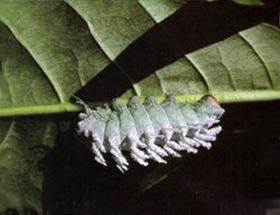|
Attacus atlas Linnaeus
Attacus atlas Linnaeus, 1758, Syst. Nat. (edn. 10), 1: 495.
Attacus atlas Linnaeus; Holloway, 1976: 85; Allen, 1981: 110; Barlow,
1982: 48; Lampe, 1985: 6.
|

Attacus atlas ♂
(.65
natural size)
|

Attacus
atlas (Saturniidae);
hatchlings; Peninsular
Malaysia (J.D. Holloway) |

Attacus
atlas (Saturniidae);
Peninsular
Malaysia (J.D. Holloway) |
Diagnosis. See note on Archaeoattacus
staudingeri Rothschild and Samia
tetrica Rebel.
Taxonomic notes. The genus Attacus is currently under revision by
R.S. Peigler. This treatment will include full details of synonymy and status
of the various names.
Geographical range. Oriental tropics to Sundaland.
Habitat preference. A. atlas ranges from lowland forests to upper montane
forest at about 2000m.
Biology. The life history as described and illustrated by Gardiner (1982)
appears to be confused with that of the next species. The egg is large,
spherical, somewhat reddish, laid in small groups.
The first instars and final instar are shown in pix. The major
difference between A. atlas and Archeoattacus edwardsii is that, in later
instars, atlas reduces the dorsal thoracic scoli to defensive glands,
leaving the dark, slender, lateral ones prominent, whereas edwardsii,
retains large dorsal scoli on the thorax, has no defensive glands, and
reduces the lateral scoli on all segments to a much greater degree than
atlas (W.A. Nassig, pers. comm.).
Pupation is in a large, stalked, brown, silken cocoon amongst leaves,
attached by the stalk to a twig.
Host-plants recorded in the Oriental Region (Sevastopulo, 1940; Pholboon,
1965; Browne, 1968; Arora & Gupta, 1979; Yunus & Ho, 1980; Miyata,
1983; Bell, MS; Bascombe, in litt.) are as follows: Anacardium, Spondias
(Anacardiaceae);
Annona, Artabotrys (Annonaceae); Schefflera (Araliaceae); Sarcostemma
(Asclepiadaceae);
Berberis (Berberidaceae); Canarium (Burseraceae); Bischofia
(Bischofiaceae);
Carpinus (Corylaceae); Dillenia (Dilleniaceae); Aleurites,
Glochidium,
Phyllanthus, Sapium (Euphorbiaceae); Teucrium (Labiatae); Cinnamomum
(Lauraceae);
Erythrina (Leguminosae); Lagerstroemia (Lythraceae); Michelia
(Magnoliaceae);
Sandoricum, Swietenia (Meliaceae); Ardisia, Embelia (Myrsinaceae);
Psidium (Myrtaceae); Nauclea (Naucleaceae); Malus
(Rosaceae);
Mussaenda, Vangueria
(Rubiaceae); Citrus (Rutaceae); Salix (Salicaceae); Schleichera
(Sapindaceae);
unspecified (Simaroubaceae); Clerodendrum (Verbenaceae).
<<Back
>>Forward <<Return to Contents page
|

